QNIX QX2710 LED DPmulti True10 Review
by Chris Heinonen on April 11, 2014 6:00 AM ESTDisplay Lag, Power Use and Color Gamut
Measured using a Leo Bodnar lag tester over HDMI, the QNIX has 33.3ms of input lag. This is likely going to be too high for most people that want to seriously game on the display. There is no game mode or anything else to reduce this input lag, though as always using a native resolution might improve the situation. This might only be by 2-3ms and so it might not make a huge difference to people.
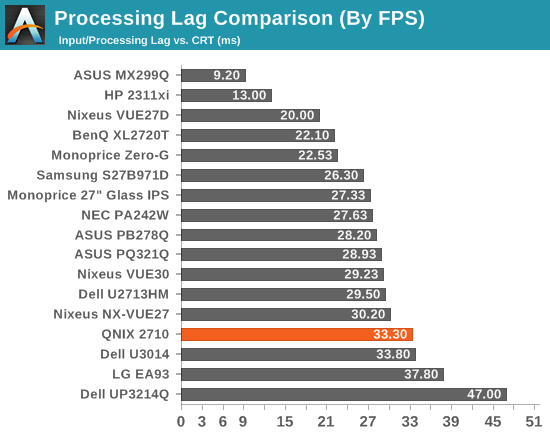
The QNIX color gamut encompasses 69.1% of the AdobeRGB gamut. This is slightly short of the sRGB gamut (which is 71% of AdobeRGB). The shortcomings are going to be in the Cyan and Blue area of the gamut as there is over-saturation in Reds and Greens. With standard white LED backlights this is expected.
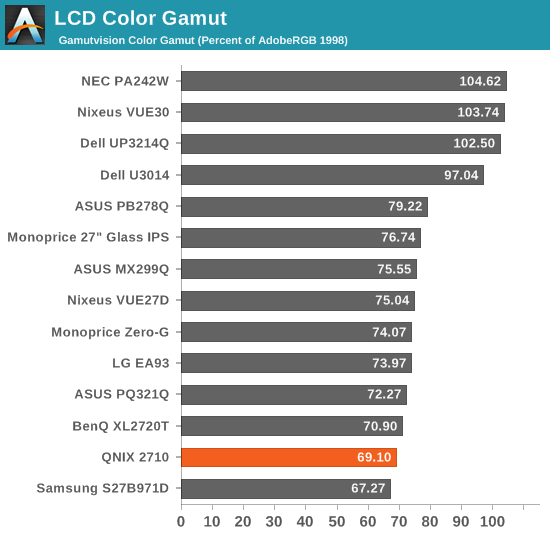
Power use is average for a 27” QHD display. The maximum light output power usage is very close to everyone else, but the minimum power usage is a bit worse. Since it is only a couple of watts difference here, it isn’t a large enough difference to even worry about. The QNIX is neither more or less efficient than other LED backlit displays on the market.
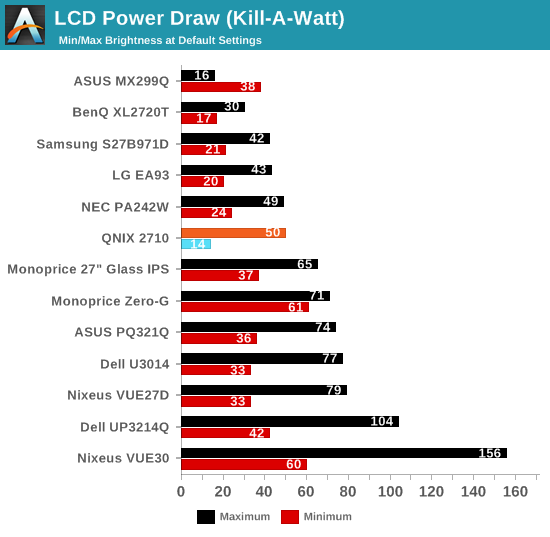
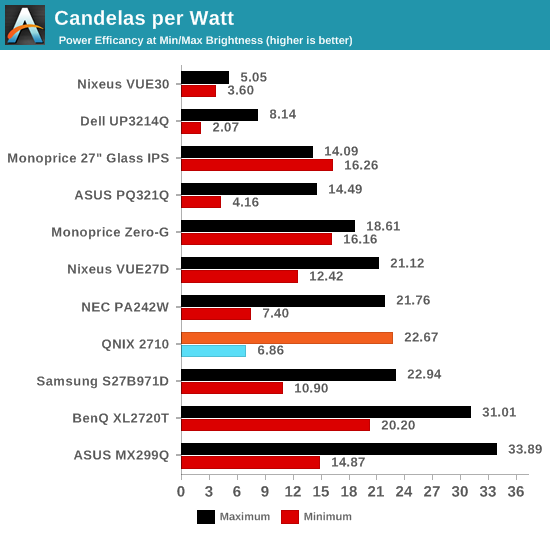


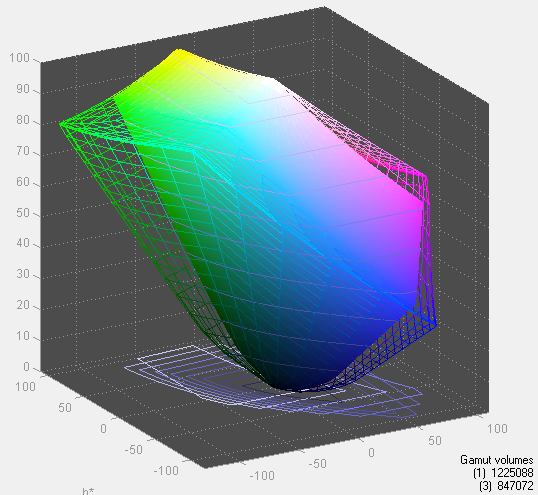








85 Comments
View All Comments
kevinsbane - Friday, April 11, 2014 - link
This model of the Qnix doesn't overclock properly. Overclocks of monitors need to be validated to verify that it doesn't skip frames when overclocked.This particular model will not show every frame of an overclock - for example, a 90hz overclock will actually result in the monitor only showing 2 out of every 3 frames. Try using the UFO test: Frame Skipping Checker to ensure that your monitor does properly overclock.
CSMR - Friday, April 11, 2014 - link
These monitors are not "best thing to happen to the computer monitor market".This is a cheap monitor and it shows.
Full of gimmicks too (integrated speakers, downscaling of 4k).
I don't know why it's appearing on Anandtech.
The front page is also unclear and doesn't state the panel type as far as I can see.
DanNeely - Friday, April 11, 2014 - link
It's here because for several years people have been requesting that some of the cheap 27" panels be reviewed for comparison with higher end models.peterfares - Friday, April 11, 2014 - link
Because the resolutions are awesome. We've been stuck at 1920x1080 for YEARS. It's about time we moved up to something better.cheinonen - Friday, April 11, 2014 - link
Because if these displays hadn't come out, we'd probably still be paying $1,000 and up for a quality 27" panel in the US. Now you can get a nice display for $450 and a really nice one for $600-650. Even if the quality of the $300 models isn't great, it has still put pressure on the pricing of the higher-end models and made them more affordable.CSMR - Friday, April 11, 2014 - link
Not sure about that. I think if you produce a high quality 27" display your main competition is other high quality 27" displays, and after than high quality 23 or 24 or 30" displays.If it were a good value cheap product I would understand. But there are much better ways to make a cheap product. Take out the frills, stick with a single displayport, skimp on casing and stand. Putting a lot of cheap parts together and adding some extra cheap parts for the hell of it is not the way to make a good value product.
Hxx - Friday, April 11, 2014 - link
Chris you made my day by reviewing this panel. Thanks for sharing with the world how awful these korean monitors actually are.JoeArchitect - Friday, April 11, 2014 - link
Don't jump to conclusions now.First of all - these aren't the monitors people want from Korea, the ones you buy are the QNix QX2710 and the X-Star DP2710 (or the Catleaps if you want to go back in time to when this started).
Secondly, for $300 you get a fairly good monitor that has a 1440p resolution and is overclockable anywhere from 96 to 120 Hz (and beyond if you're really lucky). I'm not sure if the reviewer was aware, but the monitor he selected probably actually isn't overclocked to 110 FPS. This model simply drops the frames, you have to test for frame skipping, not just what it "says" it's overclocked to. Multi-input models are widely known to do this while the single-input models actually do overclock.
The input lag the reviewer reported is also due to the multiple inputs. The single input version actually has a 2-3ms input lag, which is very good. So that downside wasn't a big surprise to many readers who have researched these panels in the past.
Now I won't deny that these (I'm referring to the desired models, not the reviewed model) monitors do have a "luck of the draw" kind of statistic to them, but even in the worst of cases purchasing a QNix or X-Star monitor gives you access to a quality panel (Samsung PLS - the one the reviewed is AHVA) that isn't available until you start spending hundres more - and those stay at 60 Hz.
For the money you spend you're getting great value, do you know of a comparable monitor that can produce >=96 Hz at 1440p on a Samsung PLS panel for ~$300? I'd love to know if you do, because I'm in the market for a new one and was going to purchase a second X-Star DP2710 because I love the one I have.
I'm disappointed in Anandtech for publishing this, they really dropped the ball and obviously didn't research much into what they were reviewing before posting this. I've been dying to see a review of the Samsung PLS model QNix and X-Stars against more expensive models, but what we got ignored a lot of community research that has been happening over the many years these inexpensive monitors have been available.
JoeArchitect - Friday, April 11, 2014 - link
As an addendum, the fact the "wrong" model was reviewed isn't bad in and of itself. The fact the misconception of the negative aspects of this multi-input model is spreading to "all Korean models" because of an utter lack of mentioning the other variants is unacceptable.I do applaud the reviewer for at least killing the misconception of this model being actually overclockable through his edit he just posted; that said, the fact the review mentions the "QNix" as not overclockable without mentioning the single-input variants which ARE is quite disheartening.
I wonder if the other reviewers on this site have an equal lack of understanding for the products they're reviewing as Chris does for monitors.
vgu - Tuesday, April 15, 2014 - link
I totally agree on all points. This seemed thoughtlessly put together and was way below the level of thoroughness I've become accustomed to on Anandtech.